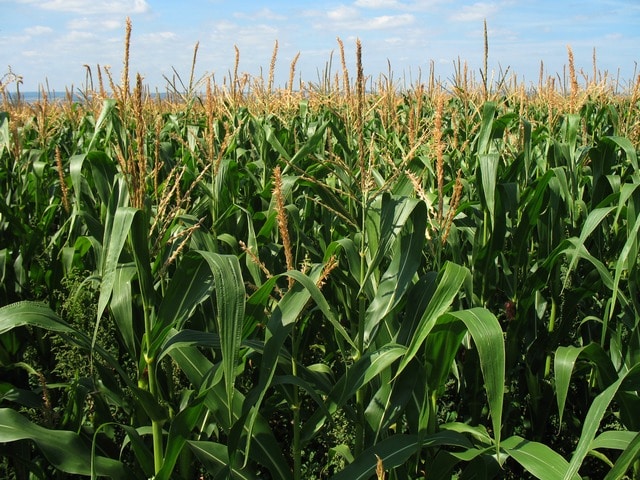Most of the important diseases of maize are foliar and the more common ones are rusts, leaf blights, leaf spots, brown spots, downy mildew, and maize streak virus (MSV).
Most of these diseases are prevalent on maize in the humid coastal and rainforest areas if the tropics and are less troublesome in the drier areas of the interior.
MAIZE RUST
Rusts are diseases characterized by the presence of roughly circular golden-yellow to brown raised structures called ‘pustules’ on the leaf or other green tissue.
Severally infected leaves dry off. The more prevalent form is that caused by the warmth-loving fungus, Puccinia polysora.
It is favored by a high temperature of about 27°C and high humidity.
Although fungicidal control is possible (e.g. Dithane S-31), the most feasible control measure is the use of resistant varieties.
MAIZE LEAF BLIGHTS
Leaf blights is a disease characterized by the appearance of spots on the leaves.
Sometimes these spots (lesions) could be many and could coalesce and make the leaves appear ‘burnt’ hence the name “blights”.
The more common one in some parts of Africa is caused by the fungus Helminthosporium maydis.
The lesions are tan and roughly rectangular. The spots appear first on the lower leaves and the disease progresses upward.
The diseases can be controlled with fungicidal sprays, e.g. Zineb, Maneb, and Cuman.
Effective maturity and this is not economically feasible. It is most effectively controlled by planting resistant varieties.
CURVULARIA LEAF SPOT
The disease is caused by the fungus Curvularia pallescens and thrives best under hot environments.
The spots are usually small and circular with grey center and brown borders.
The disease is controlled by spraying with fungicides like Miltox and Copranol but the frequency of application required for good control is too high and uneconomic.
The most feasible means of control is by planting resistant varieties.
BROWN SPOT
Brown spot is caused by Physoderma maydis. The first signs are tiny yellowish spots on the leaves which eventually turn brown.
The disease is common in humid hot climate especially when maize is repeatedly planted after maize.
Control is by well-planned crop rotation and the use of resistant varieties.
DOWNY MILDEW
Downy mildew is a very serious fungal disease of maize caused by Peronosderospora sorghii.
It has been identified as one of the most serious constraints to maize population in the forest ecology.
The spores (Conidia) are wind-borne. Infected plants show some form of chlorosis, which could be uniform or stripped depending on the particular pathogen involved.
Systematically infected plants are stunted, spindly, and brittle. Severally affected plants do not produce any ear or the tassel and ear become deformed.
Thus, plants infected at early stages suffer a 100% loss of yield.
CONTROL
Use of resistant varieties like Downy Mildew resistant (DMR) foundation seeds, SUWAN I.
- Seed dressing with appropriate chemicals eg. Apron plus or Ridomil at 2g/kg of seed.
- Rogue and destroying infected plants to prevent sporulation.
- Avoid late planting and planting in poorly drained soils in areas where the disease is known to occur.
MAIZE STREAK VIRUS (MSV)
MSV is a virus disease spread by several species of leafhoppers that belong to the genus Cicadulina.
The disease is most commonly observed on off-season crops such as maize planted late in the main seasons, on second season maize, particularly if planting is delayed and on the irrigated crops.
The leaves of infected plants show broken to almost continuous longitudinal chlorotic lines along the veins and the leaf surface.
The chlorotic streaks are caused through the failure of the chloroplasts to develop in tissues surrounding the vascular bundles.
Plants infected at an early stage of growth become stunted and produce poor cobs.
CONTROL
The most reliable method of control is the use of streaks-resistant varieties.
- Crop rotation so that invasion by infected Cicadulina is limited.
- Avoid late planting in prevalent areas.
- Control of the insect vector
INSECT PESTS
Insect pests of maize include stem borers- Busseola Fusca and Sesamia calamistis. B. Fusca is perhaps the most widespread noctuid in the African region south of the Sahara.
Stem borers affect maize grown in the late season. Control of borers can be affected by the use of insecticides, early planting, roguing of affected plants, burning of crop residues, and observing a close season.
Storage pests that affect maize are Stitophilus zeamais, Sitotroga cerelella and Tribolium castaneum.
Sitophilus zeamais, the maize in the tropics. It initially infects the maturing crop in the field and builds up and causes serious damage in the store.
The primary damage caused by this species often makes possible the introduction of secondary pests, such as the flour beetles.
Storage insects can be controlled by fumigating stores with insecticides e.g aluminum phosphide or one tablet of fumigant per two bags of maize.
In the 1980s, a larger grains borer, Phostephamus truncates (LGB), a native of Central America, invaded sub-Saharan Africa.
A predatory beetle, Teretriosoma nigrescens was introduced to east and west Africa and has reduced the problem of a severe infestation of LGB in grain stores.
NEMATODES
Nematodes may be a problem in some maize growing areas and can be brought under control by cultural practices e.g. crop rotation, intercropping, and the use of trap crops.








